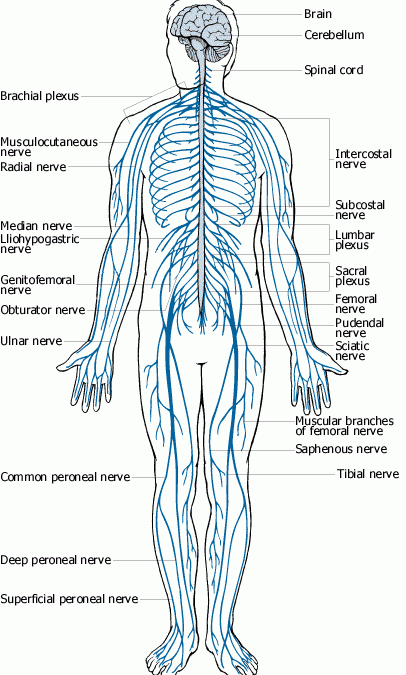The nervous system is probably the most complicated system in the human body.
The nervous system is divided into:
1. CENTRAL NERVOUS SYSTEM (CNS) which includes the brain and spinal cord.
2. PERIPHERAL NERVOUS SYSTEM (PNS) which connects the spinal cord to the nerve, sensory, and muscle fibers. The peripheral nervous system is further divided into the SOMATIC NERVOUS SYSTEM (SNS) and AUTONOMOUS NERVOUS SYSTEM (ANS).
The somatic nervous system is the under the voluntary control of the individual. It innervates the nerves that control voluntary muscle movement. The autonomic nervous system produces involuntary action of the body such as the heartbeat and digestion.
The component parts do no function independently but as a coordinated unit.
The network of nerves connects at different levels of the spinal cord which controls both conscious and unconscious activities. It is through the spinal cord that information flows from these nerves to the brain and back again. The detailed discussions of the various nervous systems are summarized below:
CENTRALNERVOUSSYSTEM
The central nervous system comprises of the brain and the spinal cord.
BRAIN
The brain is compartmentalized into two cerebral hemispheres, the cerebellum, and the brain stem. The hemispheres are demarcated into frontal, parietal, occipital, and temporal lobes. The lobe functions are described in a gross overview:
|
HEMISPHERES |
FUNCTIONS |
|
Frontal Lobe |
Voluntary muscle movement, elocution, symbolic communication (dominant side), sphincter control, intellect, behavior, and memory. Muscle groups on the left side of the body are controlled by the right side of the brain. |
|
Parietal Lobe |
Symbolic communication and calculation (dominant); sensation in all modalities, such as touch, position, pain, and temperature; intellect; memory; and spatial orientation (nondominant). |
|
Occopital Lobe |
Vision |
|
Temporal Lobe |
Symbolic communication, hearing, memory, and emotions. The cerebellum, brainstem, and accompanying cranial nerves have many discrete parts. |
THALAMUS
Sensory information relay station.
HYPOTHALAMUS
The endocrine or hormonal controlstation. Emotional control, memory, and control station for theautonomic nervous system.
MIDBRAIN
Origin of the 3rd and 4th cranialnerves. Partially houses the reticular formation, the biologicalalarm clock. Portions of all the fundamental sensory and motor(action) nerve pathways are contained herein.
PONS
Origin of the 5th cranial nerve.Portions of most of the core sensory and motor nerve pathways.Crucial cardiorespiratory station.
MEDULLA
Origin of the 6th, 7th, 8th, 9th, 10th,11th, and 12th cranial nerves. Parts of most of the main sensoryand motor nerve pathways. Critical cardiorespiratory stationlocus.
CEREBELLUM
Principally concerned with balance andcoordination.
CRANIALNERVES
| Nerves |
Functions |
|
Olfactory (I) |
Olfaction, taste |
|
Optic (II) |
Vision |
|
Oculomotor (III) |
Eye movement |
|
Trochlear (IV) |
Eye movement |
|
Trigeminal (V) |
Facial sensation, mastication |
|
Abducens (VI) |
Eye movement |
|
Facial (VII) |
Facial movement, taste |
|
Vestibulocochlear (VIII) |
Hearing |
|
Glossopharygeal (IX) |
Gag, taste |
|
Vagus (X) |
Heart, intestines |
|
Spinal accessory (XI) |
Neck muscles |
|
Hypoglossal (XII) |
Tongue movement |
SPINALCORD
The spinal cord is divided intocervical, thoracic, lumbar, and sacral segments. As a result ofdifferential growth of the spinal cord and spinal column duringgestation, the spinal cord does not occupy the entire length ofthe spinal column. The spinal cord terminates in the conusmedullaris, usually opposite the 1st lumbar vertebral body. Nerveroots leave the spinal cord from the front (ventral) and enterfrom the back (dorsal).






